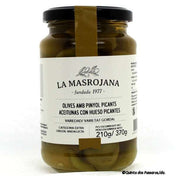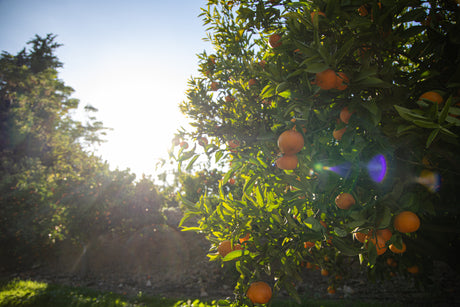The lime—small, green, and unassuming—is a true powerhouse fruit. Not only does it add a tangy freshness to food and drinks, it also offers numerous health benefits. Whether in the kitchen, at home, or in cosmetics, the lime is a multitalented ingredient that no household should be without.
Botanical background and variety
The lime originates from Southeast Asia and is now cultivated in tropical and subtropical regions worldwide. The largest producers are Mexico, India, Brazil, and Cuba, and of course, on our orange farm here in Portugal. 😊
There are several different types of limes, but the most popular are the Persian lime (also called Tahitian lime) and the Key lime . The Persian lime is larger, less acidic, and has a thicker skin, while the Key lime is smaller, more acidic, and more aromatic.
Limes are incredibly versatile and can be used in many different ways. Here are some ideas for what you can do with limes:
1. Cooking and Baking
- Marinades and dressings: Lime juice adds a fresh acidity to marinades for meat, fish, or vegetables. It also adds a touch of zest to salad dressings.
- Lime cake or tarts: Lime juice and zest give cakes, tarts and muffins a fresh, citrusy note.
- Salsas and dips: Lime juice adds a fresh touch to salsas, guacamole or other dips.
- Soups and stews: A squeeze of lime juice at the end of cooking enhances the flavor of soups, curries, or stews.
- Desserts: Limes go perfectly with panna cotta, mousse or as an ingredient in sorbets and ice cream.
2. Drinks
- Cocktails: Classics like Mojito, Margarita or Caipirinha cannot be made without limes.
- Lemonades and infused water: Limes make lemonades and water refreshing drinks.
- Hot drinks: A dash of lime juice in tea can be invigorating and helps with colds.
3. Health and Wellness
- Detox water: Lime water in the morning can help boost metabolism and detoxify the body.
- Skin care: Lime juice can help with oily skin and blemishes. It can be used as an ingredient in face masks or scrubs.
- Aromatherapy: Lime oil has a mood-enhancing effect and can be used in diffusers or baths.
4. Household
- Cleaning: The acid in limes is ideal for descaling kettles, coffee machines or as a natural cleaner for surfaces.
- Neutralize odors: A few lime slices in the refrigerator or trash can help eliminate unpleasant odors.
- Flower freshness: A splash of lime juice in flower water extends the lifespan of cut flowers.
5. Decoration
- Table decoration: Lime halves, slices or quarters are a simple and fresh decoration for summer parties.
- Flower arrangements: Limes can be beautifully integrated into flower arrangements to add a pop of color.
Limes in cosmetics and wellness
Limes are also a true miracle cure in cosmetics. They offer natural care and can be used in a variety of ways:
- Skin care: Lime juice has an astringent effect, meaning it can shrink pores and tighten skin. It's an excellent ingredient in face masks or scrubs. Lime juice also helps lighten dark spots and even out skin tone.
- Hair care: Lime juice can be used for oily hair or to reduce dandruff. It makes hair shiny and revitalizes the scalp.
- Aromatherapy: Lime oil has a mood-enhancing and refreshing effect, ideal for use in diffusers or baths.
Home remedies and traditional medicine
The lime also has a firm place in traditional medicine and in the household:
- Home remedy: A mixture of lime juice and honey is a proven home remedy for coughs and colds. Applying lime juice to insect bites relieves itching and swelling. Lime juice also helps reduce bad breath and naturally whitens teeth.
- Cleaning: Lime acid is ideal for descaling kettles and coffee machines or as a natural cleaner for surfaces.
- Insect repellent: Lime peels and juice can be used to keep insects away.
Conclusion
The lime is an amazingly versatile fruit that can be used in many areas of everyday life. Whether in the kitchen, for health, in cosmetics, or in the household – no household should be without limes. With their numerous benefits and uses, they offer a fresh, healthy, and environmentally friendly alternative to many conventional products. Harness the power of the lime and discover how it can enrich your life!
Recipe:

Ceviche: A culinary highlight made with fresh fish and limes
Ceviche is a refreshing, light dish that's especially popular in coastal regions of Latin America, especially Peru, Chile, Mexico, and Ecuador. It consists primarily of raw fish or seafood marinated in lime juice. The juice denatures the proteins in the fish, giving it a "cooked" texture without the use of heat. The result is a delicious, tender dish bursting with fresh flavors, perfect for warm summer days.
The preparation of ceviche
Preparing ceviche is simple, but requires fresh ingredients and a bit of flair:
-
The fish: Traditionally, ceviche is prepared with white-fleshed fish such as cod, sole, or sea bream. It's important that the fish is very fresh, as it's eaten raw. Seafood such as shrimp, squid, or scallops can also be used.
-
Marinade: The fish is marinated in lime juice. The acid in the lime "cooks" the fish by denaturing the proteins, giving the fish a firm yet tender texture. The fish should marinate for at least 10 to 20 minutes, depending on the type of fish and the thickness of the pieces.
-
Additional ingredients: Typical ingredients added to the marinade include chopped onions, fresh cilantro, chili (such as aji or jalapeño), and sometimes garlic. These add an additional dimension of flavor to the ceviche, ensuring a harmonious interplay of spiciness, freshness, and acidity.
-
Side dishes: Ceviche is often served with side dishes such as roasted corn (cancha), sweet potatoes, avocado, or salad. These garnishes provide a pleasant contrast to the acidity of the dish and complement the textures.
Variations of Ceviche
Ceviche comes in many variations, depending on the region and the available ingredients:
-
Peruvian Ceviche: Peruvian ceviche is perhaps the most well-known and is often served with sweet potatoes, corn, and a spicy chili broth called "leche de tigre." This broth is sometimes enjoyed as a drink and is considered particularly invigorating.
-
Ecuadorian Ceviche: In Ecuador, ceviche is often prepared with tomatoes and sometimes orange juice, which gives the dish a fruitier flavor. Seafood such as shrimp or squid is especially popular here.
-
Mexican Ceviche: In Mexico, ceviche is often served with avocado, tomatoes, and jalapeños. It's often served on tostadas (crispy corn slices) and finished with a drizzle of hot sauce.
Tips for preparing at home
If you want to make ceviche at home, here are some tips for a successful dish:
-
Choose fresh fish: Freshness is crucial! It's best to buy the fish from a trusted fishmonger on the day of preparation.
-
Use fresh limes: Lime juice is key to the marinade. Use fresh limes and squeeze them immediately before use for the best flavor.
-
Cut the fish correctly: Cut the fish into even, bite-sized pieces so that it is marinated evenly.
-
Experiment with spices: Adapt the ceviche to your taste – whether spicier with more chili, or milder with less onion and garlic.
-
Serve immediately: Ceviche should be served fresh to enjoy the best flavors and textures. Don't let it sit for too long, or the fish will overmarinate and become too firm.
Conclusion
Ceviche is a light, healthy, and flavorful dish that perfectly combines the freshness of the sea with the vibrant acidity of lime. Whether as an appetizer or a light main course, ceviche brings the flair of Latin American coastal regions to the plate and is a must-try for all lovers of seafood. Try it for yourself and discover the versatility and freshness of this unique dish!
We ship natural limes , unpreserved and untreated. The peel is untreated and therefore edible.



